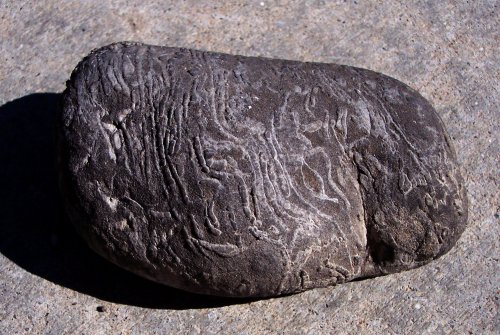Friday Rock Blogging, Mailbag Edition
Reader JM sent in today’s rock, with the assertion that it is an anomaly from the western Utah desert and not, in fact, the sort of thing you might find in a three-year-old’s nose. There is nothing in the photo for scale, but it is ~3″ long.
Here’s what I can say about this rock: wherever it came from, it’s clearly been rolling around as a cobble for a long time. I bet its P-wave velocity is 3-5 km/s. But of course the most interesting things to the casual observer are those wacky stripey inclusions - are they biogenic? Are they some kind of wacky depositional something? Being as I am a wacky hybrid of geohydrologist and seismologist, and not really a proper geologist at all, I have no idea.
Gentle readers, I am entertaining speculations from the silly to the sensible - what’s up with this rock?
delagar wrote:
Yay! I have no idea what the stripey bits are. I’m just glad Friday rock blogging is back.
Posted 29 Sep 2020 at 8:08 am ¶
Helen wrote:
Crayons! You know how you can draw on an Easter egg with white crayon, and the dye won’t stick there? Some little rock-gnome got artistic with the rock-gnome-crayon-equivalent and the erosion didn’t stick there. Or something. Maybe an ancient rock-gnome experiment in photolithography.
Posted 29 Sep 2020 at 8:49 am ¶
Lab Lemming wrote:
Could it be “structure” from a metamorphic core complex? The relief on the wavy things suffests that they are quartz (erosionally resistant) layers, possibly folded. So my first guess is a low grade metapelite with folded quartz veins.
My second guess is a welded tuff with quartz precipitated during devitrification.
Note that these two guesses require completely different geologic contexts.
so basically, I have no idea either. But I’d bet that the rock is seismically anisotropic.
Posted 29 Sep 2020 at 1:20 pm ¶
Melissa Barton wrote:
Paleoworm tracks, duh.
/making stuff up
Posted 30 Sep 2020 at 1:56 am ¶
sciencewoman wrote:
Doesn’t look like any welded tuff I’ve every seen. My first thought was metamorphic something or other. But are there many metamoprhic rx in western UT?
Posted 01 Oct 2020 at 3:10 pm ¶
Melissa Barton wrote:
Seriously, though, it’s hard to tell without seeing the texture better, but I really want to think it’s sedimentary (and that the stripey bits are secondary).
Posted 01 Oct 2020 at 3:45 pm ¶
Andrew Alden wrote:
It looks to me like a shale with soft-sediment deformation, mostly thin rip-up clasts. A laminated shale that was disturbed by slumping in a continental-slope setting. How’s that sound? But maybe if you look at the layers head-on, it’s really a trilobite orgy.
Posted 02 Nov 2020 at 12:43 pm ¶
jim wrote:
Looks like a feature found in proterozoic carbonates.
Google “molar-tooth” structure.
Or, as I would recommend, do a field run up to Glacier National Park and study the roadside rock walls.
Posted 29 Nov 2020 at 10:54 am ¶